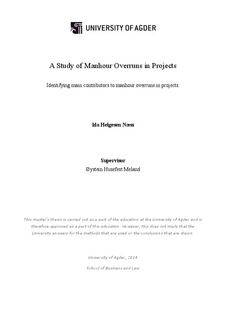| dc.description.abstract | Project manhour overrun is a common issue in all type of projects, particularly in large complex projects in the construction industry. General data on manhours and costs used in projects is available in companies’ databases, but often the time used to analyze it is an area that lack focus and dedication. This thesis tries to explain why overruns on project manhours occur, and what the main contributors are. Hopefully the result can help Project Managers to forecast more precise in future projects and improve their overall execution of Project Management. To get the necessary information to do the analysis, and get insight into how the status of Project Management is today, empirical data was based on raw project data collected from 2009 until December 2013 from five projects, supported by six Project Managers experience and knowledge through interviews. The findings in this thesis are leading towards several issues. There is a clear tendency to increase labour activity for a short-time period after a project exceeds its budget and after replacing Project Managers. The increase after exceeding budget could be overstaffing due to rework. An increase of manhours after replacements could be due to the fact that Project Managers and project team need to get an overview of the project and its workload. Replacements could also generate hours if new hires are assigned to projects. New employees require training and follow-up, which often will be performed by experienced personnel. Reduced labour activity occurs some time after a project exceeds its budget, and lasts until the end of a project. Reduced manhour activity reduce progress, and could be due to a lacking focus towards the end of a project’s life-cycle, or resource constraints due to Project Portfolio Competition. Other factors found to contribute to manhour overruns in larger projects are lack of knowledge sharing across projects and between employees, lack of direct and frequent communication with customer to collect as much information and changes as possible, lack of sufficient forecasting and re-planning due to time-constraints for Project Managers, lack of standardizations of roles, tools and processes and therefor influencing the degree of optimal use of resources. | nb_NO |
